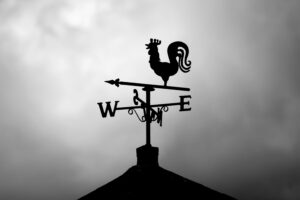How can organisations proactively look forward to identify future opportunities and threats? This series of five short think pieces examines some of the key ways that organisations can reduce the level of uncertainty surrounding what’s next.
#1: Always look both ways
Author: Richard Watson

Here’s a prediction. You are reading this because you believe that it’s important to have a sense of what’s coming next.
Or perhaps you believe that since disruptive events are becoming more frequent you need more warning about potential game-changers, although at the same time you’re frustrated by the unstructured nature of futures thinking.
Foresight is usually defined as the act of seeing or looking forward – or to be in some way forewarned about future events. In the context of science and technology it can be interpreted as an awareness of the latest discoveries and where these may lead, while in business and politics it’s generally connected with an ability to think through longer-term opportunities and risks be these geopolitical, economic or environmental. But how does one use foresight? What practical tools are available for companies to stay one step ahead of the future and to deal with potential disruption?
The answer to this depends on your state of mind. In short, if alongside an ability to focus on the here and now you have – or can develop – a corporate culture that’s furiously curious, intellectually promiscuous, self-doubting and meddlesome you are likely to be far more effective at foresight than if you doggedly stick to a single idea or worldview. This is due to the fact that the future is rarely a logical extension of single ideas or conditions.
Furthermore, even when it looks as though this may be so, everything from totally unexpected events, feedback loops, behavioural change, pricing, taxation and regulation have a habit of tripping up even the best-prepared linear plans.
In other words, when it comes to the future most people aren’t really thinking, they are just being logical based on small sets of data or recent personal experience.
The future is inherently unpredictable, but this gives us a clue as to how best to deal with it. If you accept – and how can you not – that the future is uncertain then you must surely accept that there will always be numerous ways in which the future could play out. Developing a prudent, practical, pluralistic mind-set that’s not narrow, self-assured, fixated or over-invested in any singular outcome or future is therefore a wise move.
This is similar in some respects to the scientific method, which seeks new knowledge based upon the formulation, testing and subsequent modification of a hypothesis.
The scientific method is perhaps best summed up by the idea that you should always keep an open mind about what’s possible whilst simultaneously remaining somewhat cynical.
Not blindly accepting conventional wisdom, being questioning and self-critical, looking for opposing forces, seeking out disagreement and above all being open to disagreements and anomalies are all ways of ensuring agility and most of all resilience in what is becoming an increasingly febrile and inconstant world.
This is all much easier said than done, of course. Homo sapiens are a pattern seeing species and two of the things we loathe are randomness and uncertainty. We are therefore drawn to forceful personalities with apparent expertise who build narrative arcs from a subjective selection of so called
‘facts’. Critically, such narratives can force linkages between events that are unrelated or ignore important factors.
Seeking singular drivers of change or maintaining a simple positive or negative attitude toward any new scientific, economic or political development is therefore easier than constantly looking for complex interactions or erecting a barrier of positive scepticism about new ideas that almost everyone else appears to agree upon or accept.
Next post: Hidden Assumptions
This post was written by Richard Watson, who works with the Technology Foresight Practice at Imperial College.


